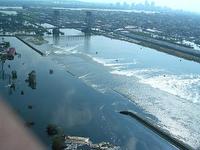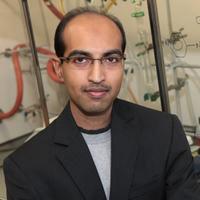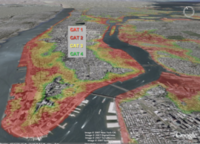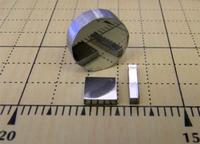-
Debate over causes of levee failure during Katrina intensifies

A court case in which residents of two sections of New Orleans are suing a construction group has put millions of dollars at stake; residents of the Lower 9th Ward and St. Bernard Parish residents claim that Washington Group International (WGI), an Amy Corps of Engineers contractor, removed several buildings and pilings from land along the Industrial Canal as part of a construction plan to expand the canal’s shipping lock, then failed adequately to plug the holes left behind; the holes allowed rainwater from Hurricane Katrina to seep underneath the 14-foot wall, essentially lifting the wall and allowing the areas to be flooded
-
-
Keystone XL pipeline: reliability of remote oil-spill sensors questioned
The oil industry plans to build thousands of miles of pipelines in the next five years, making leak detection a growing issue; many of the new pipelines will cross aquifers and rivers which are used for drinking water and irrigation; the Keystone XL pipeline has already experienced its share of controversies, and now there is a debate over the quality and reliability of the pipeline’s sensor system for remote detection of oil spills
-
-
Desalination losing ground as a solution to California’s chronic water shortage
According to the July 2011 census, more than thirty-seven million people live in California, increasing the pressure on the state’s water sources; desalinating sea water as a solution to the scarcity of fresh water is not a new technology — it has been around for more than four decades — but it has more recently been considered as a way to address California’s chronic, and growing, water shortage; a closer examination of the technology and its cost has cooled the initial enthusiasm for it
-
-
Harvesting fuel for the fleet from seawater

Refueling U.S. Navy vessels, at sea and underway, is a costly endeavor in terms of logistics, time, fiscal constraints, and threats to national security and sailors at sea; in Fiscal Year 2011, the U.S. Navy Military Sea Lift Command, the primary supplier of fuel and oil to the U.S. Navy fleet, delivered nearly 600 million gallons of fuel to Navy vessels underway, operating fifteen fleet replenishment oilers around the globe; the Naval Research Laboratory believes there is a better way: extracting carbon dioxide (CO2) and producing hydrogen gas (H2) from seawater and then catalytically converting the CO2 and H2 into jet fuel
-
-
Removing toxins from the environment

A Florida State University chemist’s work could lead to big improvements in our ability to detect and eliminate specific toxic substances in our environment; the novel approach is based on stripping electrons from the toxic chemical known as fluoride; in addition to toxin removal, the approach has many other applications
-
-
Rare Earth metals: Will we have enough?
Life in the twenty-first century would not be the same without rare Earth metals; cell phones, iPads, laptops, televisions, hybrid cars, wind turbines, solar cells, and many more products depend on rare Earth metals to function; will there be enough for us to continue our high-tech lifestyle and transition to a renewable energy economy? Do we need to turn to deep seabed or asteroid mining to meet future demand?
-
-
Specialty metals recycling policy needed: experts
An international policy is needed for recycling scarce specialty metals that are critical in the production of consumer goods; because they are used in small amounts for very precise technological purposes, such as red phosphors, high-strength magnets, thin-film solar cells, and computer chips, recovery can be so technologically and economically challenging that the attempt is seldom made
-
-
Exploring solutions to growing water shortages
Most Americans do not pay much attention to how much water they use when they take a shower or when they water the grass, but Michael Sullivan, a global executive at IBM thinks this will change; “Water is a finite resource,” Sullivan told a panel in a conference on water policy; “What we’re dealing with is that there’s a finite supply, and as the population grows and industry grows, we’re stressing that finite supply”
-
-
Wearable map-creating device to help first responders
A wearable sensor system automatically creates a digital map of the environment through which the wearer is moving; the system is envisioned as a tool to help emergency responders coordinate disaster response
-
-
New York unprepared for flooding, sea level rise

New York City may be a fast paced city of bright lights, sleek attitudes, fashion trends, and some of the best sports teams in the country, but underneath the glitz and glamour is a city which is not prepared for an act of God and which is being threatened by rising sea levels and severe storm flooding; “It’s a million small changes that need to happen,” one expert says
-
-
Thermoelectric material converts heat waste to electricity

Scientists have developed a thermoelectric material which they claim is the best in the world at converting waste heat to electricity; this is very good news, since nearly two-thirds of energy input is lost as waste heat
-
-
Limiting world trade unlikely to reduce CO2 emissions
The United States emits less CO2 in the production of its exports than is contained in its imports, simply because it imports more than it exports; only about 20 percent of CO2 transfers from China into the United States can be traced back to the fact that China is in effect relatively more specialized in the production of dirty goods; interventions in world trade, like CO2 tariffs, would probably have only a small impact on global emissions
-
-
Microstructural improvements enhance material properties
DARPA merges structural engineering principles with new fabrication technologies to demonstrate microstructural control of materials at the micron level; the ultimate objective of the agency’s Materials with Controlled Microstructural Architecture (MCMA) program is to be able to develop materials in the future with properties tailored to meet specific mission requirements
-
-
U.S. models underestimates costs of carbon pollution
Model used by government all but ignores economic damages that climate change will inflict on future generations; two economists argue that when these costs are factored in, the real benefits of carbon reduction range from 2.6 to more than 12 times higher than the government’s estimate
-
-
Threat-recognition technology incorporates mind, machine

For soldiers operating in the field, the ability to detect threats from standoff distances can be life-saving; when advanced radar and drone coverage is not available, soldiers typically rely on their own vision to scan their surroundings; DARPA links human brainwaves, improved sensors, and cognitive algorithms to improve target detection
-
More headlines
The long view
Autonomous Vehicle Technology Vulnerable to Road Object Spoofing and Vanishing Attacks
Researchers have demonstrated the potentially hazardous vulnerabilities associated with the technology called LiDAR, or Light Detection and Ranging, many autonomous vehicles use to navigate streets, roads and highways. The researchers have shown how to use lasers to fool LiDAR into “seeing” objects that are not present and missing those that are – deficiencies that can cause unwarranted and unsafe braking or collisions.
Tantalizing Method to Study Cyberdeterrence
Tantalus is unlike most war games because it is experimental instead of experiential — the immersive game differs by overlapping scientific rigor and quantitative assessment methods with the experimental sciences, and experimental war gaming provides insightful data for real-world cyberattacks.
Prototype Self-Service Screening System Unveiled
TSA and DHS S&T unveiled a prototype checkpoint technology, the self-service screening system, at Harry Reid International Airport (LAS) in Las Vegas, NV. The aim is to provide a near self-sufficient passenger screening process while enabling passengers to directly receive on-person alarm information and allow for the passenger self-resolution of those alarms.
Falling Space Debris: How High Is the Risk I'll Get Hit?
An International Space Station battery fell back to Earth and, luckily, splashed down harmlessly in the Atlantic. Should we have worried? Space debris reenters our atmosphere every week.
Testing Cutting-Edge Counter-Drone Technology
Drones have many positive applications, bad actors can use them for nefarious purposes. Two recent field demonstrations brought government, academia, and industry together to evaluate innovative counter-unmanned aircraft systems.
Strengthening the Grid’s ‘Backbone’ with Hydropower
Argonne-led studies investigate how hydropower could help add more clean energy to the grid, how it generates value as grids add more renewable energy, and how liner technology can improve hydropower efficiency.
